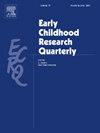Multidimensional patterns of early care and education access through a family centered lens
IF 3.2
1区 教育学
Q1 EDUCATION & EDUCATIONAL RESEARCH
引用次数: 0
Abstract
Despite evidence of the benefits of early care and education (ECE) for child development and family employment, the supply of providers is scarce and variable; leading many families with young children to experience limited and inequitable access. To examine the multidetermined nature of access, this study leverages a multidimensional, family-centered definition and a nationally representative sample of families of preschoolers from the Early Childhood Longitudinal Study – Birth Cohort to examine (1) patterns of access-related features present in preschool-age children's ECE arrangements, and (2) child characteristics, household circumstances, and care setting type that may be related to patterns of access. Latent class analysis model enumeration revealed five latent classes of children's nonparental care arrangements along features of accessibility: High Across Most Access Features (26.4 %), Single, Long-Term Provider (30.1 %), Limited Across Most Access Features (11.6 %), Low Affordability, Multiple Providers (10.1 %), and High Affordability, Recent Transition (21.8 %). These results suggested many children were in ECE that met multiple dimensions of access, with others in care arrangements that reflected trade-offs. Children were also differentially classified into types of ECE arrangements in relation to care setting type, race/ethnicity, income, household urbanicity, and parental employment. The implications of investigating ECE access as a multidimensional construct, and recommendations for how ECE providers and policy can more closely align with family needs are discussed.
以家庭为中心透视早期保育和教育机会的多维模式
尽管有证据表明,早期保育和教育(ECE)对儿童发展和家庭就业大有裨益,但提供者稀缺且不稳定,导致许多有幼儿的家庭在获得早期保育和教育的机会方面受到限制且不公平。为了研究幼儿保育和教育的多决定性,本研究采用了多维度、以家庭为中心的定义,并从 "幼儿纵向研究-出生队列"(Early Childhood Longitudinal Study - Birth Cohort)中抽取了具有全国代表性的学龄前儿童家庭样本,以研究:(1)学龄前儿童的幼儿保育和教育安排中与保育和教育相关的特征模式;(2)可能与保育和教育模式相关的儿童特征、家庭环境和保育环境类型。潜类分析模型枚举揭示了儿童非父母托育安排中与可获得性特征相关的五个潜类:大多数可获得性特征高(26.4%)、单一、长期提供者(30.1%)、大多数可获得性特征有限(11.6%)、可负担性低、多个提供者(10.1%)和可负担性高、近期过渡(21.8%)。这些结果表明,许多儿童所接受的幼儿教育符合多方面的入学条件,而其他儿童所接受的保育安排则体现了权衡利弊的原则。根据保育机构类型、种族/民族、收入、家庭城市化程度和父母就业情况,儿童被划分到不同的幼教安排类型。本文讨论了将幼儿教育机会作为一个多维结构进行调查的意义,并就幼儿教育提供者和政策如何更密切地满足家庭需求提出了建议。
本文章由计算机程序翻译,如有差异,请以英文原文为准。
求助全文
约1分钟内获得全文
求助全文
来源期刊

Early Childhood Research Quarterly
Multiple-
CiteScore
7.00
自引率
8.10%
发文量
109
期刊介绍:
For over twenty years, Early Childhood Research Quarterly (ECRQ) has influenced the field of early childhood education and development through the publication of empirical research that meets the highest standards of scholarly and practical significance. ECRQ publishes predominantly empirical research (quantitative or qualitative methods) on issues of interest to early childhood development, theory, and educational practice (Birth through 8 years of age). The journal also occasionally publishes practitioner and/or policy perspectives, book reviews, and significant reviews of research. As an applied journal, we are interested in work that has social, policy, and educational relevance and implications and work that strengthens links between research and practice.
 求助内容:
求助内容: 应助结果提醒方式:
应助结果提醒方式:


